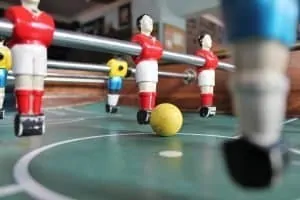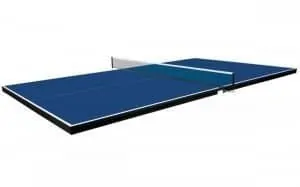So you’ve decided to take up the game of ping pong. Firstly, congratulations! It’s a great game and a superb addition to any game room. You will not regret it! Next though, where do you start?
As a popular recreational activity, many players starting out just pick up a paddle and aim to figure it out. Having seen many friends and colleagues go down this path, some initial guidance can make a big difference in your development.
With that in mind, I’ve put together this guide to give beginners an understanding of the key skills required in their early development.
I started playing ping pong at the age of 5 and have over 30 years of experience playing recreationally.
Where my ping pong skills fall short, I’ve been able to make up for with research. Using experience, feedback from coaches and internet research, I’ve detailed what you should know to help get you started.
What’s the difference between table tennis vs ping pong?
There is no difference! Ping pong was first used by John Jaques and Son, who trademarked the name exclusively for their equipment.
After more equipment manufacturers started to emerge, they decided to use the name table tennis. Since then the two terms have been used interchangeably but the official name for the sport is Table Tennis.
What do you need to get started with Ping Pong?
Let’s first take a look at what equipment you need. At a basic level, to get started you require:
- A ping pong table with a net. You can review some of our recommendations of the best ping pong tables.
- A ping pong paddle. You can review some of our recommendations of the best ping pong paddles for beginners or the best overall ping pong paddles.
- At least 1 ping pong ball.
- And preferably, you need a partner to play with. Although many tables do offer a single player mode these days.
That’s it! Quite simple.
The good news for ping pong players is that once you have the basic equipment, it tends to last for some time if proper care is taken. The table is the most expensive, followed by the paddle and then the balls.
You will only need to purchase a new set of balls every so often and you may decide to upgrade your paddle in 6-12 months. Depending on the quality of the table and the care taken, it should last for 3-5 years.
Basic Ping Pong rules
Now that you have your equipment sorted, we’ll take a look at some of the basic rules to understand as a beginner. You can review the full set of rules from the International Table Tennis Federation (ITTF) if you’re interested.
General gameplay
- The game can be played between two players (singles) or four players (doubles)
- In singles, the centre line that divides the table sides can be ignored. For doubles, this is used to mark four quadrants to guide where the serve must bounce in doubles.
- Each player plays with 1 paddle.
- The aim is to score more points than the opponent to win a game.
- Each point starts with a player serving the ball.
- Once the ball is in play after a serve, players take turns to hit the ball and bounce it on the opponent’s side of the table.
- The edges of the table are part of the legal table surface, but not the sides.
- If the ball hits the net, but continues to bounce on the opponent’s side of the table, then the ball is still in play.
- After each game, the players switch sides.
- In the final game (ie 5th game), the players switch side again after either player reaches 5 points.
Scoring
- A competitive match is won by winning an odd number of games, normally 3 out of 5 games.
- For each game, the first player to reach 11 points wins that game. Although a game must be won by at least a two-point margin. So if scores a tied at 10-10, the winner score must be at least 12-10 for a player to win.
- Many players play to 21 or 15 instead, which is fine for recreational play.
- A point is scored each time the ball has been put into play. Unlike volleyball where a point is only awarded on the winners serve.
- Points are awarded for the following:
- When serving, a point will be awarded to the opponent if:
- The serve hits the net and bounces on the server’s side of the table; or
- The serve does not bounce once on each side of the table.
- Once in play, a point is awarded to you if the opponent:
- Does not return the ball back at all;
- Let’s the ball bounce twice on their side before returning the ball;
- Returns the ball but hits the net, with the ball falling on their own side;
- Returns the ball but does not land the ball on their your side of the table;
- Allows the ball to hit their body;
- Hits the ball twice.
- When serving, a point will be awarded to the opponent if:
Legal serving
A player can gain an important advantage in the match if they make it difficult for the opponent to return their serve. That is why the ITTF has an entire section in their handbook on correct serving.
Here’s a quick overview of the correct way of serving. You can also view a more detailed breakdown of ping pong serving rules.
- The ball must rest on an open hand palm. It must be tossed up at least 6 inches and struck so the ball first bounces on the server’s side and then the opponent’s side.
- If the serve hits the net but is still legal, this is called a let. Let serves are not scored and are reserved.
- In contrast to popular theory, there is no limit to the number of let serves.
- Players alternate serves with each player serving two points in a row.
- In a tiebreak (eg. if the score is 10-10) then each player serves only one point and then the server is switched.
To get started with a legal serve, see this introduction video:
Basic Ping Pong skills
Now that you have grasped the rules – don’t worry we wouldn’t expect you to remember them all – its time to understand the skills you’ll need to learn.
Paddle Grip
Probably one of the most important skills to learn is the way to correctly hold the paddle. There are two common grips, known as Shakehand or Penhold.
The shakehand grip mimics shaking someone’s hand and is the more traditional grip used in western countries.
The penhold grip is similar to holding a pen, where a player holds the paddle between his thumb and index finger. It’s not a common grip and can be difficult for beginners. This grip was mastered and is most common with Asian players.
Take a look at the below video to help you get a better understanding of each.
We recommend practising with both to get a feel for which you feel more comfortable with. There are no advantages of choosing one over the other, each goes down to the player’s personal preference.
Once you decide on which grip to use, it’s important to get comfortable with the correct way from the beginning. This will help you enhance your skill development further down the track.
Hand-eye coordination
To play table tennis you need a basic level of hand-eye coordination. Similar to other racquet sports like baseball or tennis, you need to learn to follow the ball by keeping your eyes on it all times.
Then being able to hit the ball at the right moment so that it travels to the designated spot is where you will become more precise the more you play.
If you’re not comfortable initially, use the single-player mode of your table to get familiar with how the ball and paddle work together.
Stance and body positioning
As well as having the right paddle grip, it is critical that you learn the correct stance and body position. Proper body positioning can be the difference between making a return shot or not. It also helps you play desired shots correctly.
The ready position is the recommended stance by professionals for receiving the serve or returning the ball.
Here’s an over of how to effectively position your body to be in the ready position:
- For right-handed players, they should be positioned slightly to the left of the center of the table. For left-handed players, its the opposite.
- Give yourself enough distance from the edge of the table while holding the paddle out in front of you. You’ll know the correct distance if the paddle is in line with the table’s edge (or your paddle just touches the table edge).
- Right-handed players will need to have their left foot slightly forward and their feet about shoulder width apart. As you get better you might find your stance widening to give you a better centre of gravity. Again for left-handed players, it’s the opposite.
- Finally, your legs should be slightly bent to allow you to spring to the right or left if a wide shot is played.
This position will give you the best possible chance to make a return and is especially useful if playing against a powerful opponent.
Footwork
While the ready position is critical in helping you make strokes, it’s no good if you stand in the same place. It’s strange to think but most beginners have their feet pegged to the ground.
Moving them will make you more nimble and give you the opportunity to react quickly to your opponent’s shots. There’s no magic to how to move your feet but we recommend keeping slightly on your toes at first. This will help you become more agile and remind you to move your feet during play.
Stroke play
Now that you have learned the correct body positioning its now time to learn your strokes. As a beginner, you should keep things simple but learn your basic backhand and forehand strokes.
A common mistake beginners make is sticking to the stroke that they feel more comfortable with. In the end, this exposes a visible weakness to opponents as they continue to position their body towards their more dominant side.
The four main backhand and forehand strokes are the drive and the push. The drive is a more aggressive, attacking stroke, whereas the push is a more defensive stroke. Check out the lessons from the below videos to master these.
Backhand and forehand drives
Backhand and forehand push
Learn how to put spin on the ball
As you get more comfortable with how the ball reacts off the paddle, you can slowly start experimenting with adding spin to the ball.
This is done by flicking the wrist side-to-side or up-and-down right as the ball is hit. Being effective at spin can take years to master so just practise to see what works for you.
Serving effectively
Being able to deploy an effective serve can help you dictate and control the point from the outset.
The key is to put the ball in a difficult position for the opponent to make their return. You should avoid easy serves against better opponents at all costs, as it will give them time to decide which stroke to play to get on the attack.
There are a range of techniques, but they mainly boil down to power or spin, or a combination of both.
For beginners, we recommend aiming for a more flat but powerful serve as this is somewhat easier to learn. Again you’ll need some time to get this right, but the key is to keep varying the angle of the paddle when it hits the ball and the amount of force you apply.
Returning the serve
If learning how to serve can help dictate the game, then the return of serve is just as important because you only serve for half of the time.
Whether you’re starting out or a seasoned pro, it’s important to keep an eye on the ball as well as how the opponent is serving. For example, are they applying any spin on the ball? Is it topspin or backspin? Or are they going for a power serve?
This will help you preempt where the ball will land. Used with the ready position it will allow you to have more time to react, decide which stroke to play and where you want the ball to land. This will help you get on the offensive and control the game.
Power serves are easier to judge the trajectory of the ball as they travel in a straight line. But quick reflexes are needed to get the paddle in the right position to make an effective return.
Spin serves can be the most difficult to return. Unlike power serves, you may have more time to judge where the ball will land, but its harder to know how the ball will react off your paddle. The amount of spin will also be influenced by the type of paddle and table you are using.
Practice
You’re almost at the end of the article and if you’ve come this far, you should have a basic understanding of how to effectively start your ping pong career.
But learning by knowing isn’t the same as learning by doing and you’ll only develop your skills if you dedicate time to practise.
Once you’re familiar with the basic strokes, we recommend focussing your practice on timing and keeping the ball low.
Your timing will get better with more game time. Improving your timing will help you return more difficult shots and turn defence into attack.
Keeping the ball as low and having it travel just above the net is a difficult skill to master. Although it will help put more pressure on your opponent and make it difficult for them to hit an easy return shot back.
More information
We hope you’ve enjoyed our guide on How to play ping pong. If you have the chance to use some of the concepts outlined this article it will only help you become a better player.
If you’re wanting to know more, check out our 10 ping pong tips for beginners.



